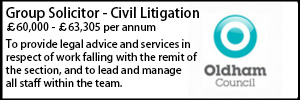Confidentiality Rings
- Details
Helen Prandy sets out the key considerations when confidentiality rings are employed in procurement cases.
With apologies to the ‘Pass Notes’ section of a well known national newspaper this blog is a short but informative (we hope) summary of (nearly) everything you need to know about Confidentiality Rings.
Why?
We won, my competitor has no right to see my competitive advantage…it’s genius, brilliant and innovative…
In the words of Fraser J “In procurement litigation, the confidential information of other parties (namely the other bidders) will usually by held by the contracting authority. Although it will not inevitably be relevant to the claim by the dissatisfied bidder, it will often be relevant."
If it is relevant then the ordinary rules of disclosure in litigation apply and it should be made available to a party in litigation.
What is a confidentiality ring?
A confidentiality ring allows the parties in litigation to exchange confidential information relating to each other, and third parties, in a safe space whereby the information can be protected by limiting who sees it and how it is handled.
Whilst there might be some scepticism, particularly on the part of third parties, about the effectiveness of these safeguards they do appear to work and their use is provided for in the TCC Guide to Procurement Claims.
Who is in a confidentiality ring?
The lawyers for the unsuccessful bidder will always be within the confidentiality ring on provision of undertakings about how they will handle the information disclosed.
Lawyers, however, are not subject matter experts and will usually need a representative of their client within the Confidentiality Ring who is capable of understanding the information, giving instructions and, potentially giving factual evidence at trial.
A suggestion that one of your competitors should see your confidential information never goes down well with winning bidders. However, Fraser J made it very clear in SRCL v The National Health Service Commissioning Board that such a representative should be in the confidentiality ring and that if the identity of an individual cannot be agreed the matter should be placed before the court.
It is possible to put in safeguards around such an individual by, for example, limiting where they can view the documents and restricting their involvement in other procurement exercises for a limited time.
When does the need for a confidentiality ring arise?
Since the case of Roche Diagnostics Limited v The Mid Yorkshire Hospitals NHS Trust the court has generally expected contracting authorities to release their evaluation materials at an early stage. This has also been formalised within the TCC Guide. Some evaluation material effectively discloses the content of third party bids so it is becoming increasingly common to see a confidentiality ring established before any litigation in order to deal with that confidential information.
Otherwise some form of confidentiality ring will generally be established if legal proceedings are issued.
But remember…..
The legal system in England & Wales operates on the principle of ‘open justice’. Restricting access to documents or holding hearings in private in whole or part is exceptional. The confidentiality ring is now a well-recognised mechanism in procurement claims but the information protected by the confidentiality ring must be genuinely confidential and it is not enough simply to assert that it is. A good reason must be given and that reason may be examined by the court if confidentiality is disputed. Anything not deemed confidential will be available to the parties and, indeed, the public at large.
And nothing lasts forever….
Whilst it is not always true that today’s confidential information is tomorrow’s chip paper (to borrow a phrase) most commercially sensitive information has a limited time during which it is truly confidential. In that case, it is not just during the course of litigation that information may be disclosed but also under the provisions of the Freedom of Information Act.
Freedom of Information Act?
We’ll come to that in another blog….maybe.
Helen Prandy is a Principal Associate at Mills & Reeve. She can be contacted on 01223 222344 or
Must read
Local authority legal teams after Mazur
Antisocial Behaviour Legal Officer
Regulatory/Litigation Lawyer
Solicitor - Litigation
Locums
Poll
18-03-2026 1:00 pm
01-07-2026 11:00 am


























